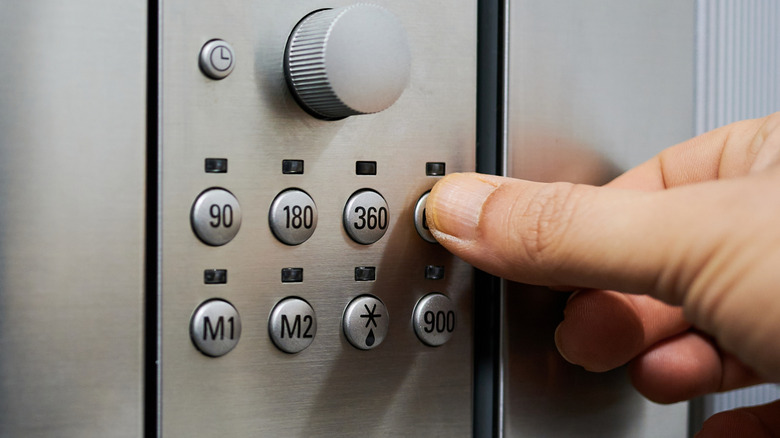How To Use The Microwave Defrost Setting Correctly (And Safely)
We may receive a commission on purchases made from links.
We know the defrost button is on just about every microwave, but most home chefs are stumped on how to use it optimally. While the scientific inner workings can get complicated, the process is not. To properly defrost any food without complex calculations, use this rule of thumb: For each pound of frozen food, add eight to 10 minutes to the defrosting time. If you're thawing 2 pounds of burger meat, for example, go for 16 minutes total. If you're bringing a 5-pound brisket to room temperature, the defrosting process takes about 50 minutes. This obviously takes a lot longer than it would to simply reheat the same foods as leftovers, but it beats waiting a whole day for food to thaw in the fridge — and with much more predictable results.
When you select the defrost setting, it automatically turns the power level down to 20% to 30%, which ensures your food thaws instead of cooks. It all has to do with a special device in your machine known as the magnetron, which transmits electromagnetic waves into your food, creating heat. Hitting the defrost button limits the frequency at which the magnetron runs, which means slow, even warming for your deeply chilled cuisine.
The defrosting process isn't always one-size-fits-all
For the most accurate results, microwave ovens often come with more sophisticated settings that ensure you thaw your food correctly. If math isn't your thing, check your microwave's owner's manual to see if it has an auto defrost feature. With this button, you enter a code or number that's correlated with a specific cuisine, the weight of your frozen fare, and hit start. There may also be a weight defrost setting on your unit, with a similar process that's slightly less specific to the type of food you're warming up. Just select the weight defrost feature, enter the food's weight, and you're good to go. Some microwaves let you enter the metrics in pounds, while others calculate with ounces. If things get confusing, keep a conversion chart or kitchen scale nearby.
Wattage also plays a role in the thawing process. The number of watts your device has converts to its overall potential power. The higher the wattage, the faster and stronger the energy output. You can usually adjust this on your microwave via its power settings. For defrosting purposes, a unit that has an 800‑watt capacity or higher is strong enough to melt thick layers of frozen food.
Is it safe to defrost food in the microwave?
We get it. If you're unsure of how to use the defrost setting, you may be worried it isn't safe. You may have heard of the infamous "danger zone", an ambient temperature range between 40 and 140 degrees Fahrenheit that invites unwanted bacteria into your meat and produce. If you raise the temperature of raw foods, even in the microwave, they are susceptible to this phenomenon.
The simplest way to avoid any foodborne illness from defrosted foods is to immediately cook them after defrosting. Harmful microbes can double in just 20 minutes, so even forgetting something in the microwave for half an hour can be a problem. Instead, while your frozen fare thaws, take that time to prepare everything else you need to cook so you're ready to go. It's also essential to use a microwave-safe container. We recommend you opt for glass, such as the Pyrex glass food storage container set, which passes the dishwasher, freezer, microwave, and oven tests with flying colors. This means you could theoretically pull the food out of the freezer, pop it in the microwave, and transfer it into the oven without dirtying a single pan. Other options include microwave-safe plastic containers, a freezer-safe gallon bag, or a paper plate.


